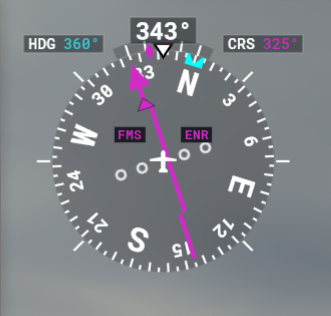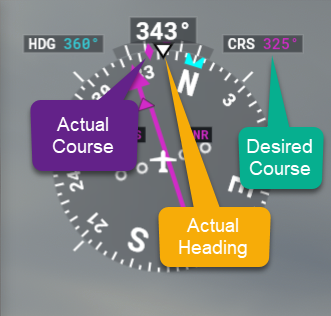In some ways, the Patagonia bush trip is much easier to fly than the Nevada trip. This is due to the improved instruments in the CubCrafters XCub that’s used for the journey.
Some may not like the extra help desiring more of a challenge. It is possible to ignore the extra help. See Balkan Bush trip: How to make it more of a challenge - #2 by Hambone6563
For the rest of us, the help is appreciated if we know how to take advantage of it. Here is a little explanation of the course indicator seen in the external view of the aircraft.

The course indicator is designed to help the pilot stay on course. The course indicator changes its pointer to point to the direction that the pilot should fly for each leg of the course. If the pilot observes the needle, he can ignore the timing for each leg, and adjust his course when it changes on the course indicator.
Exactly what is indicated in the course indicator? Look at the following graphics.

The CRS field specifies the specific course for the leg you are flying. In this case 325 degrees, or northwest. If you notice, the magenta arrowhead is pointed to 325 in the center dial of the gauge.
The white triangle points to the actual heading of the aircraft. This may or may not be equal to the actual course of the plane due to the wind pushing the aircraft off to one direction or another away from the heading. Above the triangle, the heading is given in degrees, 343.
The magenta diamond points to the actual course of the aircraft due to crabbing for the wind. In this case, the airplane is flying toward compass heading 335, according to the inner dial. This is due to a 13 kph crosswind from 60 degrees.
The diamond helps the pilot by relieving him from having to calculate for the crosswind.

In the center of the gauge, a white airplane is depicted representing the airplane’s relationship to the intended course. The planned course is represented by the straight magenta line next to the aircraft. The farther the magenta line is from the center of the gauge, the farther off course is the aircraft. Each circle represents about 1 nm. If you deviate further than that, the distance is shown explicitly.
This helps the pilot know where his plane is in relation to the intended course and how to correct for it. When the magenta line moves to the left or the right, the pilot can get back on path by flying toward the bar. This means he should turn to move the magenta diamond to the left or right of the magenta arrowhead. Eventually, the magenta line will move back toward the center, at which time the aircraft can be turned to center the magenta diamond over the arrowhead.
The trick is not to overcorrect. If you are only a little off course, a small angle to the left or right is enough to correct for it and makes it easier to readjust as necessary once you get the plane back on course.